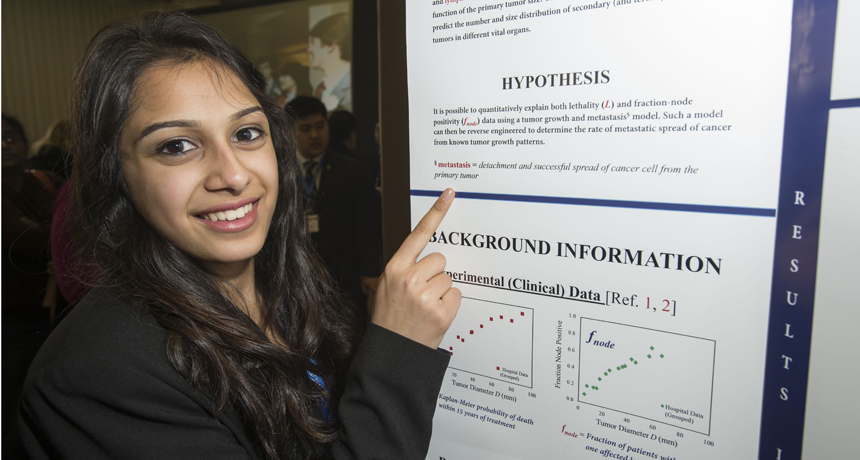Intel STS finalist uses math to predict breast cancer spread
Inspired by her grandmother, Esha Maiti put statistics to use in medicine

Esha Maiti shows off her project at the Intel Science Talent Search. She developed a mathematical model to predict breast cancer spread.
Chris Ayers Photography/SSP
Esha Maiti, 17, decided she wanted to study cancer after her grandmother passed away from misdiagnosed breast cancer. But at first she wasn’t sure where to start. Esha hit on her method in 10th grade. “I was in statistics class, and there was one of those Fun Fact boxes in my text book that talked about Monte Carlo simulations,” she says, “and I was thinking of cancer when I read that box, so I thought, ‘Oh! Maybe I could use a probabilistic method.’”
The senior at California High School in San Ramon, Calif., brought her mathematical predictions to the Intel Science Talent Search. The annual contest, run by Society for Science & the Public, brings 40 of the country’s brightest high school seniors to Washington, D.C., to show off the results of their research.
Cancers like breast cancer usually begin as a single tumor. The cells in the tumor have mutated, so they can no longer stop growing and dividing. When a tumor spreads, some of the cancer cells break off and move to other areas of the body, such as the lymph nodes or lungs. There the tumor cells take up residence and become secondary tumors, growing on their own.
At first, many of these secondary tumors, called metastases, are very small, less than a tenth of an inch (two millimeters). Most scans that doctors use cannot detect something that small. By the time the tumors grow big enough to detect, options for treating the cancer may be limited. And those secondary tumors can then start making new tumors of their own.
Esha wanted to see if she could use statistics to predict where breast cancer might spread. She tried the Monte Carlo method. It uses a computer program to pick random numbers from a particular number set over and over. The distribution of the numbers shows how likely a particular outcome is. In this case, Esha had the computer program select random numbers that reflected the probability of cancer spreading to the lymph nodes, to other areas in the body or not spreading at all.
“This model means that from the earliest stages of breast cancer, people could have a way to probabilistically tell where their tumors are likely to be,” Esha explains. While her math can’t attack cancer directly, she hopes that it will help patients to know more about their diagnosis. It could also help doctors. If they know where the cancer is most likely to spread, they can figure out the best course of treatment.
Esha is going to continue pursuing her passion, and hopes to study computational mathematics. She has always loved statistics and probability. “I love the idea of calculating to figure out exactly how important something is relative to anything else,” she says. Esha is off to a great start, she has published her work in a scientific journal, the Physical Review E.
Power Words
cancer The rapid, uncontrolled growth of abnormal cells. It can lead to tumors, pain and death.
computational mathematics A branch of mathematics that uses computer programs to describe what is known about numbers and their relationships to each other, to predict or calculate the properties of other numbers.
lymph A colorless fluid produced by lymph glands. This secretion, which contains white blood cells, bathes the tissues and eventually drains into the bloodstream.
lymph glands (or lymph nodes) Organs that are part of the lymphatic system, small nodules located in the armpits, groin and stomach. They produce lymph and also serve as a storage place for cells in the immune system.
metastasis The spread of cancer from one organ to another. Cancer cells separate from the original tumor and can use the lymphatic system or blood vessels to move around the body, where they can form tumors in other organs.
Monte Carlo method A series of computational methods that repeatedly sample a set of numbers. By picking numbers at random over and over again, the Monte Carlo method can predict something unknown, such as the shape of a pictured object or the risk of cancer spreading to other areas of the body.
probability A measure of how likely something is to occur.
statistics The science of interpreting data, and in particular of reducing or estimating errors attributable to random variation.
tumor A mass of cells characterized by atypical and often uncontrolled growth. Benign tumors will not spread; they just grow and cause problems if they press against or tighten around healthy tissue. Malignant tumors will ultimately shed cells that can seed the body with new tumors. Malignant tumors are also known as cancers.







